#graphene
Text
They're putting graphene in everything
150 notes
·
View notes
Text
Their vision is to make a mass spectrometer where all the key components can be 3D printed, contributing to a device with much less weight and cost without sacrificing performance. There is still a lot of work to do, but this is a great start.
58 notes
·
View notes
Text
🪤💉🪤💉🪤GRAPHENE 🪤💉🪤💉🪤
⚰️⚰️⚰️
#graphene#danger#warning#health hazards#inoculation#heath#health care#crimes against humanity#covid#jabs#say NO to 💉💉💉#fight for justice#speaktruth#standup#speak up#truth#please share#wwg1wga#corruption#worldwide
54 notes
·
View notes
Text
The super-special material graphene continues to surprise and fascinate scientists, this time revealing a rare electronic state termed 'ferro-valleytricity', which occurs when graphene is stacked up in a particular five-layer combination.
When in this new state, the graphene stack exhibits weird and wonderful magnetic and electronic behavior, as reported by researchers from the Massachusetts Institute of Technology (MIT), Harvard University, and the National Institute for Materials Science in Japan.
Using graphene in this way could help in the development of both classical and quantum computers, according to the team, especially in terms of creating data storage solutions that offer large capacities but that also need relatively little energy to run.
"Graphene is a fascinating material," says physicist Long Ju from MIT. "Every layer you add gives you essentially a new material."
"And now this is the first time we see ferro-valleytricity, and unconventional magnetism, in five layers of graphene. But we don't see this property in one, two, three, or four layers."
Continue Reading.
70 notes
·
View notes
Text
Dr Jane VINDICATED: I BROKE THE STORY IN JULY 2021 OF GRAPHENE IN PFIZER SHOTS & WAS DEFAMED BY SHILLS Reuters & Dr. Ryan Cole who called me "a screwed up drunk" New Federal court ordered documents vindicate my 2021 reports on @la5acolumna discovery of graphene in shots! @Reuters and @drcole12 OWE ME AN APOLOGY





64 notes
·
View notes
Text

Researchers create first functional semiconductor made from graphene
Researchers at the Georgia Institute of Technology have created the world's first functional semiconductor made from graphene, a single sheet of carbon atoms held together by the strongest bonds known. Semiconductors, which are materials that conduct electricity under specific conditions, are foundational components of electronic devices. The team's breakthrough throws open the door to a new way of doing electronics.
Their discovery comes at a time when silicon, the material from which nearly all modern electronics are made, is reaching its limit in the face of increasingly faster computing and smaller electronic devices.
Walter de Heer, Regents' Professor of physics at Georgia Tech, led a team of researchers based in Atlanta, Georgia, and Tianjin, China, to produce a graphene semiconductor that is compatible with conventional microelectronics processing methods—a necessity for any viable alternative to silicon.
Read more.
32 notes
·
View notes
Text
#graphene#Dopamine_sensor#electrochemistry#sensor#Electrochemical_sensor#Nanosensor#Biosensor#Dopamine#Voltamammetry
6 notes
·
View notes
Link

#wooden bike#sustainable mobility#aerodynamic geometry#graphene#Timber Bike#Timber Mobility Project#wood#inovation#bicycles
14 notes
·
View notes
Text
Green hydrogen successfully produced from plastic waste
Scanning electron microscope (SEM) image of layered stacks of nano-scale flash graphene sheets formed from waste plasticKevin Wyss/Tour lab
Low-emissions strategy that could pay for itself helps scientists achieve high-yield hydrogen gas and high-value graphene.
Climate change has made scientists seek renewable energy where it can be found. While manufacturing products out of waste is on the…

View On WordPress
7 notes
·
View notes
Text
“Truly Mind-Boggling” Breakthrough: Graphene Surprise Could Help Generate Hydrogen Cheaply and Sustainably
5 notes
·
View notes
Photo

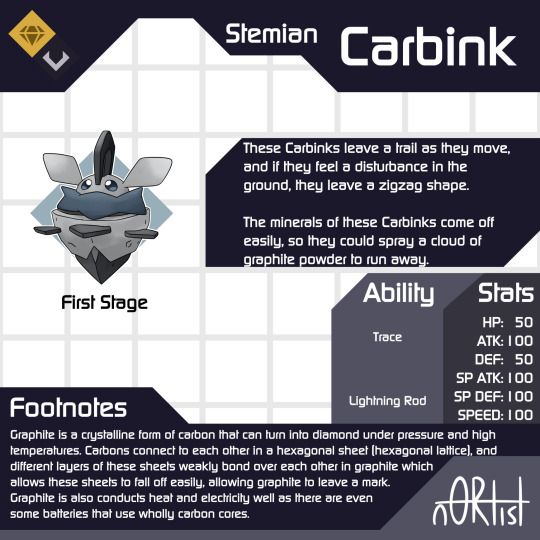

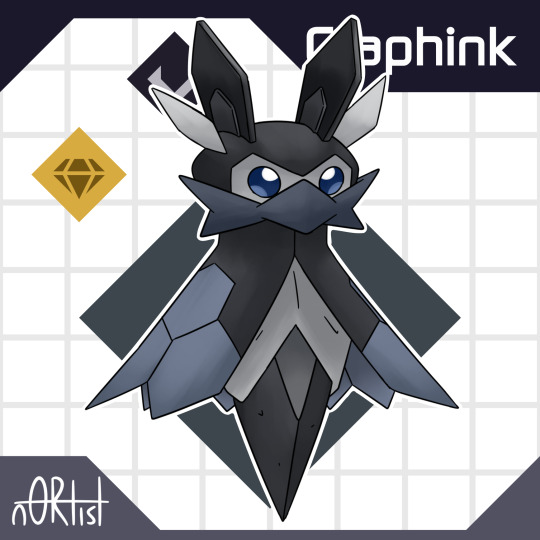

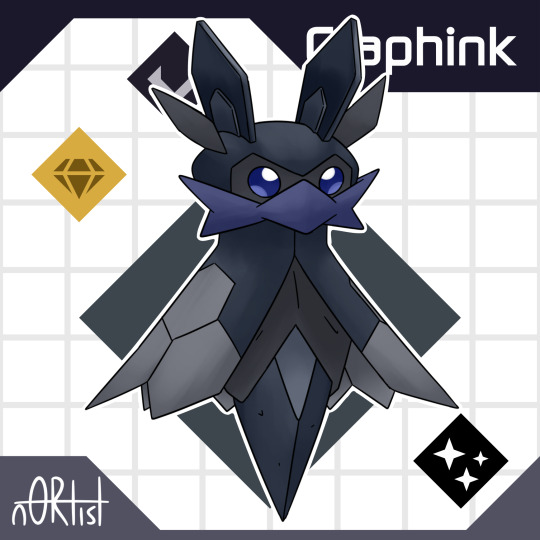
This was based off of a #STEMARegional submission by @Ringu_u on Twitter that I selected to include in my region.
I also gave this Carbink an evolution based off of graphene, a single layer of double-bonded carbons.
As with any regional mons that deal with canon ones, these designs are separate from the region, and the Stema Region is not dependent on canon mons.
This is a Carbink that was originally about seismographs and detection of disturbances in the ground. Seismographs often use a pen (or through creative liberty, a pencil) to record any disturbances. Later, a more direct reference to graphite was made where graphite is crystallized carbon, turning into diamond under heat and pressure. Carbon links to itself in sheets and there is a weak Van der Waals force between the sheets. It is so weak that sheets of carbons can come out of the graphite, allowing it to leave a mark behind.
Carbink (Rock/Dark): These Carbinks leave a trail as they move, and if they feel a disturbance in the ground, they leave a zigzag shape. The minerals of these Carbinks come off easily, so they could spray a cloud of graphite powder to run away.
Graphink (Rock/Dark): Graphinks wear a super thin coat which allows them to make little to no sound as they zip around in the dark. Graphinks scout the wild to detect danger which is when they would zigzag back to whoever they are loyal to to warn them.
#pokemon#art#fakemon#science#physics#carbon#graphite#education#stem#Logic & Passion#steam#oc#regional variant#carbink#nanoscience#graphene#regional evolution
116 notes
·
View notes
Text
Researchers from Umeå have found a new way to synthesize graphene oxide which has significantly fewer defects compared to materials produced by most common method. Similarly good graphene oxide could be synthesized previously only using rather dangerous method involving extremely toxic fuming nitric acid.
11 notes
·
View notes
Text
2 notes
·
View notes
Link
Old plastic from scrapped cars can be converted into graphene by grinding it to dust and zapping it with high-voltage electricity, a process that could save large amounts of plastic from landfill.
Graphene is a form of atom-thick carbon with a number of useful electrical and material properties. James Tour at Rice University in Texas and his colleagues have previously found that plastic could be converted into graphene via a process called flash joule heating, where material is heated to temperatures generally in excess of 2700°C by passing high voltages through it.
They have now worked with car manufacturer Ford to show that this graphene can be used to manufacture new parts for cars, and that those new parts can again be recycled into fresh graphene.
“You don’t have to bury this stuff anymore,” says Tour. “You just turn it into graphene, put it in your new composite, then, when you’re done with those composites after 50 years, flash it again, turn them into graphene and put it into composites again.”
Continue Reading.
348 notes
·
View notes
Text
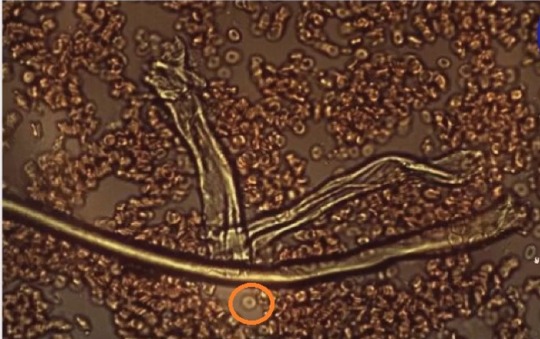
“You can see the size of the graphene fibres in relation to the size of a red blood cell. Fibres of this size will block capillaries. You can also see the graphene fibres are hollow and contain red blood cells.”
4 notes
·
View notes
Text
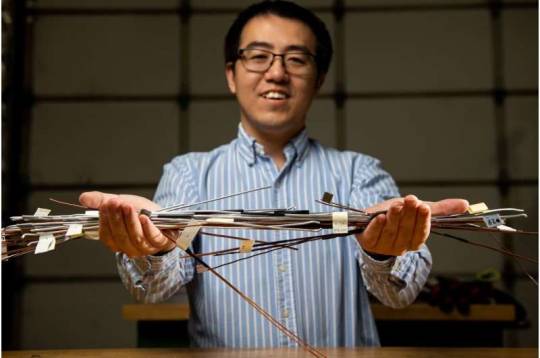
Adding a small amount of solid carbon to copper boosts its conductivity
A common carbon compound is enabling remarkable performance enhancements when mixed in just the right proportion with copper to make electrical wires. It's a phenomenon that defies conventional wisdom about how metals conduct electricity.
The findings, reported in the journal Materials & Design, could lead to more efficient electricity distribution to homes and businesses, as well as more efficient motors to power electric vehicles and industrial equipment. The team has applied for a patent for the work, which was supported by the Department of Energy (DOE) Advanced Materials and Manufacturing Technologies Office.
Materials scientist Keerti Kappagantula and her colleagues at DOE's Pacific Northwest National Laboratory discovered that graphene, single layers of the same graphite found in pencils, can enhance an important property of metals called the temperature coefficient of resistance.
Read more.
37 notes
·
View notes